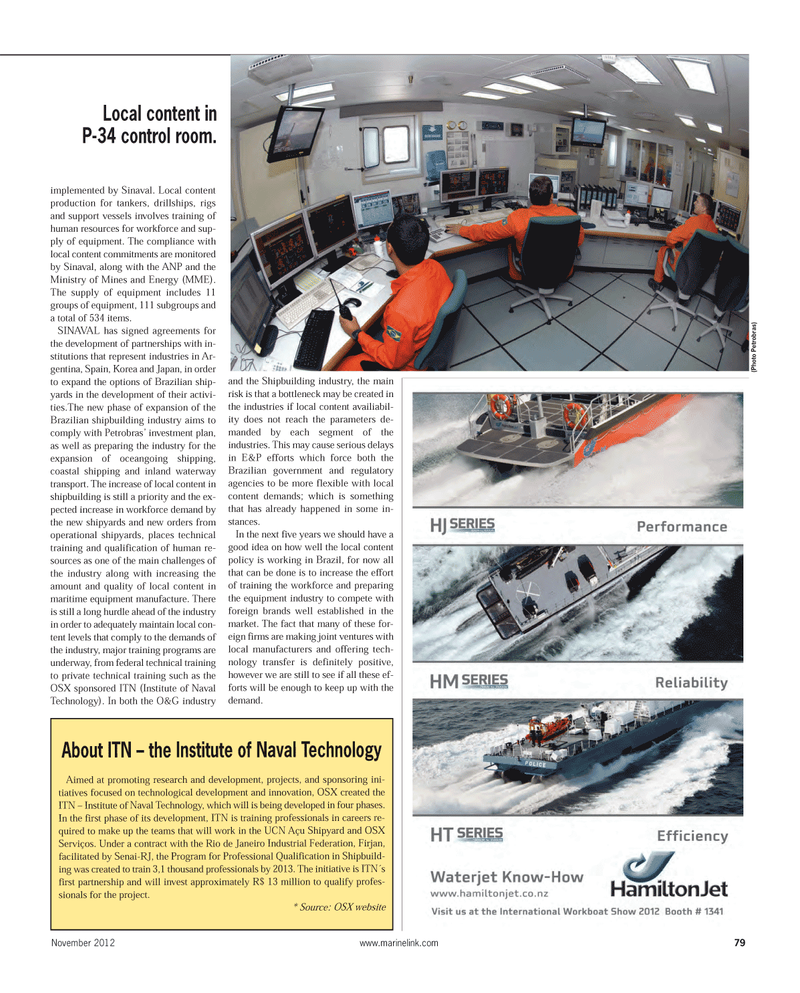
Page 79: of Maritime Reporter Magazine (November 2012)
Workboat Annual
Read this page in Pdf, Flash or Html5 edition of November 2012 Maritime Reporter Magazine
implemented by Sinaval. Local content production for tankers, drillships, rigs and support vessels involves training of human resources for workforce and sup- ply of equipment. The compliance with local content commitments are monitoredby Sinaval, along with the ANP and the Ministry of Mines and Energy (MME). The supply of equipment includes 11groups of equipment, 111 subgroups anda total of 534 items.SINAVAL has signed agreements for the development of partnerships with in- stitutions that represent industries in Ar- gentina, Spain, Korea and Japan, in order to expand the options of Brazilian ship- yards in the development of their activi- ties.The new phase of expansion of the Brazilian shipbuilding industry aims to comply with Petrobras? investment plan, as well as preparing the industry for theexpansion of oceangoing shipping, coastal shipping and inland waterway transport. The increase of local content in shipbuilding is still a priority and the ex- pected increase in workforce demand by the new shipyards and new orders from operational shipyards, places technical training and qualification of human re- sources as one of the main challenges ofthe industry along with increasing theamount and quality of local content inmaritime equipment manufacture. There is still a long hurdle ahead of the industryin order to adequately maintain local con-tent levels that comply to the demands of the industry, major training programs are underway, from federal technical training to private technical training such as the OSX sponsored ITN (Institute of Naval Technology). In both the O&G industry and the Shipbuilding industry, the main risk is that a bottleneck may be created inthe industries if local content availiabil- ity does not reach the parameters de-manded by each segment of the industries. This may cause serious delays in E&P efforts which force both the Brazilian government and regulatory agencies to be more flexible with local content demands; which is somethingthat has already happened in some in-stances. In the next five years we should have a good idea on how well the local content policy is working in Brazil, for now all that can be done is to increase the effort of training the workforce and preparing the equipment industry to compete withforeign brands well established in themarket. The fact that many of these for- eign firms are making joint ventures with local manufacturers and offering tech- nology transfer is definitely positive, however we are still to see if all these ef- forts will be enough to keep up with the demand.November 2012www.marinelink.com 79Local content in P-34 control room. (Photo Petrobras) About ITN ? the Institute of Naval Technology Aimed at promoting research and development, projects, and sponsoring ini- tiatives focused on technological development and innovation, OSX created the ITN ? Institute of Naval Technology, which will is being developed in four phases. In the first phase of its development, ITN is training professionals in careers re- quired to make up the teams that will work in the UCN Açu Shipyard and OSX Serviços. Under a contract with the Rio de Janeiro Industrial Federation, Firjan,facilitated by Senai-RJ, the Program for Professional Qualification in Shipbuild- ing was created to train 3,1 thousand professionals by 2013. The initiative is ITN´s first partnership and will invest approximately R$ 13 million to qualify profes- sionals for the project.* Source: OSX website MR#11 (74-81):MR Template 11/6/2012 8:16 AM Page 79

 78
78

 80
80
